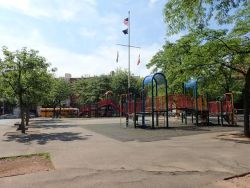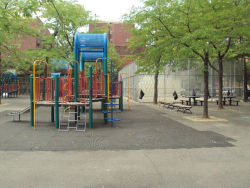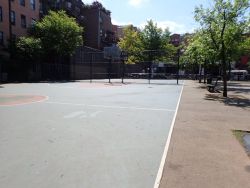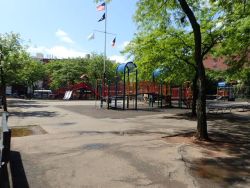Sarah J.S. Tompkins Garnet Playground
Sarah J.S. Tompkins Garnet Playground
What was here before?
This section of Williamsburg, Brooklyn was largely rural from the 1600s to the mid-1800s. At the turn of the century, it was mostly industrial with many lumberyards, including New York and Brooklyn Casket Company, the Rode and Horn Lumber Company, Inc., and Samrode Corporation—all formerly on this site.
How did this site become a playground?
In 1937, the City of New York bought this property from the lumber companies for park purposes and demolition commenced later that year. In 1987, it was named Middleton Playground, for the adjacent street, which itself was named for Arthur Middleton (1742-1787), a signer of the Declaration of Independence.
Who is this playground named for?
In 2021, as part of the second phase of NYC Parks’ initiative to expand the representation of African Americans honored in parks, this playground was renamed for educator, suffragist, and first Black New York City school principal Sarah Jane Smith Tompkins Garnet (1831–1911).
Garnet was born on August 31, 1831, one of eleven children born to Sylvanus and Anne Smith, prosperous pig farmers and early settlers of Weeksville, a large community of free Blacks in central Brooklyn. Garnet’s sister Susan McKinney Steward (1847-1918) was the first African American woman to earn a medical degree in New York, and the third in the United States. She also has a park in Brooklyn named for her.
From an early age, Garnet expressed an interest in education and began her career as a school monitor at the age of 14. In a career spanning nearly four decades, she worked her way up from an assistant at the African Free School in Williamsburg, Brooklyn, to serving as the City’s first Black principal at integrated School No. 81 and later School No. 80, both in Manhattan. She retired from education in 1900.
In addition to her work as an educator, Garnet was active in the suffrage movement. For many Black suffragists, women’s right to vote was a step towards civil rights for all. In 1902 she founded the Equal Suffrage League, which met at her home and at a YMCA in Fort Greene. Garnet was active in the National Association of Colored Women, later leading the organization’s Suffrage Department, and was a delegate to the Universal Races Congress in 1911.
Garnet married Reverend Samuel Tompkins in the 1850s, with whom she had two children before becoming a widow just a few years later. In 1879, she married abolitionist Reverend Henry Highland Garnet (1815-1882). She died at her home in Bedford-Stuyvesant on September 17, 1911, just days after she was honored by the Equal Suffrage League. She is buried in Brooklyn’s Green-Wood Cemetery. Among the speakers at her memorial service was activist and NAACP co-founder W.E.B. DuBois (1868-1963). In 2019, P.S. 9 Sarah Smith Garnet was renamed in her honor.
Check out your park's Vital Signs
Clean & Safe
Green & Resilient
Empowered & Engaged Users
Share your feedback or learn more about how this park is part of a
Vital Park System




